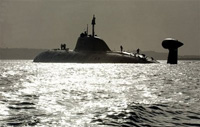Nerpa and freon
Viktor Ishayev, the governor of Russia’s Khabarovsk region, rejected the human factor as a possible reason for the breakdown on board the Nerpa nuclear submarine, which killed 20 and injured 21. “The introductory investigation shows that there were no actions taken by the crew. The so-called human factor has not been discovered,” Interfax quoted the governor as saying.

A preliminary official version of the tragedy says that the tragedy occurred on account of the inadvertent occurrence of function of the fire-extinguishing system, which released freon gas into two front compartments of the submarine. Twenty people – three servicemen and 17 civil individuals – died as a result of gas poisoning.
Experts, however, believe that the accident occurred because of the human factor and not the technical malfunction. Everything on board the sub that can be tested is tested at the factory at first and then at the pier, above the water surface. Afterwards, they say, submarines are tested for their performance under the water.
There were 208 people staying on board the submarine, including 81 military men. Other people were members of the inspection board, employees of the shipbuilding factory and counteragents for other enterprises which made various devices for the sub.
“There were many outsiders on board to conduct all the tests. As a rule, these people do not know how to behave on board the submarine. They only know how to fix a device which they made at their enterprises. No one of them has ever been to a submarine before, but they want to find themselves there, because it is a financially profitable initiative. It is not ruled out that it was them who caused the state of emergency,” an expert said on conditions of anonymity.
“Contractors drink a lot during tests, they do it all the time. Someone could simply light up a cigarette in a compartment, which activated the fire extinguishing system. Someone else was probably sleeping in the compartment and was unable to understand what was going on there,” the expert added.
The Nerpa submarine was outfitted with up-to-date automatic fire extinguishing system on the insistence of Indian customers. All the instructions for the system were written in English.
Freon is used in if fire breaks out on board, but the source remains unknown. It is only the commander who orders to release freon. However, the system on the Nerpa submarine was activated automatically.
The K-152 Nerpa is a 8,140-tonne (8,010-long-ton) Project 971 Shchuka-B (NATO: Akula II) type nuclear-powered attack submarine. Construction was started in 1991, but suspended due to lack of funding. K-152 Nerpa was launched by the Amur shipyard in October 2008 and is planned to be leased to the Indian Navy in 2009, following which it would be rechristened INS Chakra. 'Nerpa' is the Russian word for the Baikal Seal.
Igor Kurdin, a former Typhoon-Class submarine commander, and the current head of the St. Petersburg Submariners Club attributed the high casualty count to the presence of a large number of civilian specialists on the submarine at the time of the accident. He noted that civilian observers would be untrained in the proper response to the release of the boat's fire fighting gas, which would be preceded by a specific light and sound signal, after which all on board are supposed to put on gas masks to allow them to survive during the 30 minute period required to ventilate the compartments before they can be reopened. In addition, because the accident occurred at 8:30 PM many of the civilian specialists and crewmen would likely have been asleep, and unable to don their gas masks in time. All but three of the dead were civilians.
The submarine belongs to the Pacific Fleet. Her construction started in 1991, but was delayed due to lack of funding. The accident was the country's worst since 2000, when torpedo explosions sank another Russian nuclear submarine, Kursk, killing 118 people.
Subscribe to Pravda.Ru Telegram channel, Facebook, RSS!




